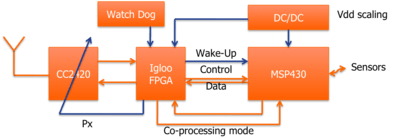PowWow

PowWow (Power Optimized Hardware and Software FrameWork for Wireless Motes) is a wireless sensor network (WSN) mote developed by the Cairn team of IRISA/INRIA. The platform is currently based on IEEE 802.15.4 standard radio transceiver and on an MSP430 microprocessor. Unlike other available mote systems, PowWow offers specific features for a very-high energy efficiency:[1]
- the MAC layer is based on an asynchronous rendezvous scheme initiated by the receiver,
- architectural and circuit level optimizations were performed such as power management, frequency and voltage scaling and FPGA co-processing for low power,
- the software stack is very light (5 kbytes) uses event-driven programming and is currently derived from the Protothread library of Contiki.
Hardware[2]
PowWow hardware platform is composed of a motherboard including an MSP430 microcontroller and of other daughter boards such as the radio transceiver board, the coprocessing board and some sensor and energy harvester boards.

Processing motherboard
- TI MSP430 low-power microcontroller
- MSP430F1612 version, 8 MHz clock
- 55KB of flash memory, 5KB of on-chip RAM
- 330uA at 1 MHz and 2.2 V in active mode, 1.1uA in standby mode
- P1, P2 connectors for extension
- JTAG, RS232 and I2C interfaces
Radio Board
- TI CC2420 RF transceiver
- Digital direct sequence spread spectrum baseband modem
- Single-chip 2.4 GHz IEEE 802.15.4 compliant
- Spreading gain of 9 dB, data rate of 250 kbit/s
- Hardware support for packet handling, data buffering, burst transmissions, data encryption, data authentication, clear channel assessment, link quality indication and packet timing information
Co-processing Board
A co-processing board can be added to the motherboard on P1, P2 connectors. This board provides dynamic voltage scaling and hardware acceleration to increase the energy efficiency of the network.
- Power Mode Management (PMM)
- Low-Power Programmable Timer for Wake-up period
- MAX6370, 8uA
- Dynamic Voltage and Frequency Scaling (DFVS)
- Programmable Clock
- LTC6930, 490uA
- 8 MHz divided by 1 to 128
- Programmable DC/DC converter
- TPS62402/TPS61030
- Programmable Clock
- FPGA co-processing
- Low-power Igloo FPGA from Actel
- AGL125: 130 nm, 125 kgates, 32kbits on-chip RAM, 1 kbits Flash, PLL for clock management.
- Supply voltages 0 to 1.65V
- Power consumption: 2.2 uW, 16 uW, 1 to 30 mW in sleep, freeze, run modes
- e.g. Viterbi decoder for link layer implemented on the FPGA consumes 5 mW
Networking
- MAC layer: preamble sampling protocol
PowWow uses RICER[3] protocol proposed by UC Berkeley to reduce the time spent in radio reception (RX) mode. This protocol consists in cycled rendez-vous initiated by a wake-up beacon from potential receivers. Thanks to this method, nodes are sleeping most of the time, hence saving energy.
- Multi-hop routing
- Geographical routing
PowWow uses a simple geographical routing protocol.
- Each node has (x,y) coordinates
- Next node for hop transmission is chosen in the neighbors as the nearest to the destination
in the sense of Euclidean distance
- Neighbor table management
- A neighbor is a node in the radio range of a node
- Neighbors are discovered at power-up and on regular time period
- Transmission modes
- Broadcast
- Direct transmission to {neighbors}, no ACK
- Flooding
- Broadcast a packet to all network nodes, no ACK
- Direct Hop with/without ACK
- Direct transmission to a specific neighbors with/without ACK
- Robust Multi-Hop
- Multi-hop transmission to a specific node in the network
- Each hop is with ACK
- Uses node address
- Broadcast
Software
PowWow software distribution provides an API organized into protocol layers (PHY, MAC, LINK, NET and APP). The software is based on the protothread library of Contiki, which provides a sequential control flow without complex state machines or full multi-threading.
- Memory efficiency: 6 Kbytes (protocol layers) + 5 Kbytes (application)
- Over-the-air re-programmation (and soon reconfiguration)
Development Tools
- Currently based on IAR Embedded Workbench
- Compiling with gcc for MSP430 is also possible
- Energy estimation methodology[4]
Availability
The first version of PowWow were released July, 2009. PowWow V1 includes the motherboard, the radio board and the software. A first prototype of the coprocessing board is currently available but not yet distributed. PowWow V2 is under development.
PowWow is delivered as an open source hardware and open source software under the GPL license.
External links
Sources
- ↑ O. Berder and O. Sentieys. Powwow : Power optimized hardware/software framework for wireless motes. In Proc. of the Workshop on Ultra-Low Power Sensor Networks (WUPS), co-located with Int. Conf. on Architecture of Computing Systems (ARCS 2010), pages 229–233, Hannover, Germany, February 2010.
- ↑ http://powwow.gforge.inria.fr/subpages/Hardware.html
- ↑ Lin, E.-Y. A., Rabaey, J. M., Wolisz, A. : Power-efficient rendez-vous schemes for dense wireless sensor networks. In Proc. of the IEEE Int. Conf. on Communications, Paris, France, June 2004.
- ↑ M.M. Alam, O. Berder, D. Menard, T. Anger, and O. Sentieys. A hybrid model for accurate energy analysis of wsn nodes. EURASIP Journal on Embedded Systems, 2011.
| ||||||||||||||||||||||||||||||||||